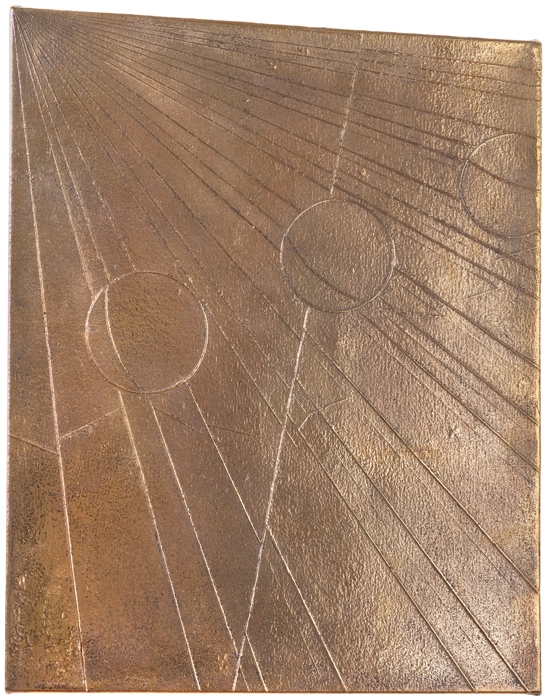Modernist geometric abstraction insisted on art’s presentness, proscribing memory, illusion, allusion – anything that pointed beyond the frame. During the early 2000s, several artists emerged, among them Martin Boyce, Sergej Jensen, David Maljkovic and Katja Strunz, who saw ironic potential in turning this bias on its head, using formalism to retrospectively allude to the absolutist claims – of transcendence and finality – that modernist artists had made for it. Tomma Abts is among the most distinguished survivors of that generation, but she has never been an ironist. She proceeds as if earnest persistence could overcome the nostalgia to which her paintings seem condemned, and, failing that, elegiacally acquiesce to the obsolescence of the languages they draw on.
Abts’s paintings are puzzles, literally and metaphorically: literally because they might be examples of what W.H. Auden called art as a ‘contraption’ (he first approached a poem by asking, ‘How does it work?’). An Abts painting comes right ‘with a click like a closing box’ – as another great modernist, W.B. Yeats, described finishing a poem – resolving mechanism into image. But these are oddly purposeless illusions, picturing nothing but their own structures, their forms hermetically contingent on each other, committed to perpetual motion among themselves. Abts’s meticulous layering of hard-edged planes of colour fetishises her painstakingness, but the illusionism towards which it strives is self-concealing: the real time of painting gives way to the figurative time of an image’s retrospection, by sinking into the shallowest of pictorial spaces. This sleight of hand is what traditional painting has always used its imagery for; it only seems paradoxical here because it is so exclusively self-reflexive. Repeatedly, Abts bets everything on this spartan payoff. She is ultimately unlike the modernists she alludes to, who sought to supplant late-nineteenth-century aestheticism. For them, an emphasis on the artwork as a contraption was a vigorously realist alternative to a moribund formalism that had lost contact with life. Abts’s art has the pure aestheticism of the arcanely artisanal, the skill no one else has the patience to master. This is l’art pour l’art – like Fabergé eggs, or Flemish still lifes, but without the bonus of luscious fruit and flowers.
Her paintings are almost always the same size (an upright 48 x 38cm), and when they are not – like the fussily decorative I. (2016) – they stray into pictorial issues they seem unequipped to deal with. They are titled by names that sound like no one’s name, and therefore nothing one can empathise with, their alienation exacerbated by the aura-cultivating distance that always separates them. The relatively recent inclusion of shaped canvases, punning between composition and canvas, might be a sophisticated joke on what art historian Michael Fried called ‘deductive structure’ – the making of a painting’s design totally contingent upon its support – if it didn’t seem a category error to speak of Abts making jokes.
This exhibition pivots around another extrapolation from her staple form: Jelto (2017) is a solemnly tarnished, slightly skewed rectangle of bronze, a painting-as-ingot, casting what appears to be one of her paintings (the bronze registers the canvas’s tooth). Adumbrating form in the absence of colour contrasts, a spectrum of tracks, raised in shallow relief, recedes into the top left corner, diversified by three circles, like planets suspended in a burst of cosmic rays. The result is tautological: paintings designed to invest modernist presentness with the memory of its history are turned into what might be their fossils. Jelto’s receding vectors take the soberly consequential momentum of Abts’s process and freeze it into a sign for what it alludes to. They recall the fanning segments of Mark Grotjahn’s monochrome ‘Butterfly’ paintings, which, as hermetic formalism at the same time as an image of radiating light or a butterfly’s wingspan, reformulate well-lauded tropes from the modernist past, while acknowledging that their original claim to formal autonomy is no longer viable.
Abts’s art is both limited and distinguished by its inability to make such worldly distinctions. Jelte (2017) is a composite of painting and cast, divided two-thirds of the way across, as if one were metamorphosing into the other, present into past, image into the image of an image, across the force field between canvas and bronze. Its kitschy trompe l’oeil effects – pebbledash speckling, tonal gradation, drop shadows, the bronze’s representation of canvas – are less functional illusions than forms of ornament that embroider the painting’s language, as if to compensate for lapses of memory. Perhaps all of Abts’s ingenuity is only needed for lack of a real object to remember.
10 November – 13 January 2018
From the March 2018 issue of ArtReview
